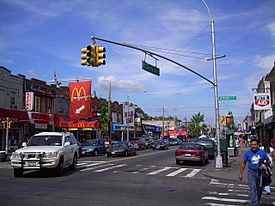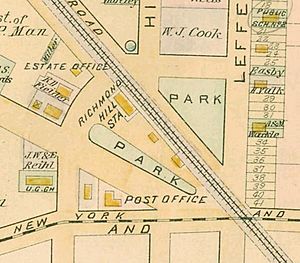Richmond Hill, Queens facts for kids
Quick facts for kids
Richmond Hill
|
|
|---|---|
|
Neighborhood
|
|

Liberty Avenue intersecting with Lefferts Boulevard in Richmond Hill.
|
|
| Nickname(s):
Little Guyana
Little Punjab |
|
| Country | |
| State | |
| City | New York City |
| County/Borough | Queens |
| Community District | Queens 9 |
| Founded | 1868 |
| Named for | Edward Richmond |
| Population
(2010)
|
|
| • Total | 62,982 |
| Race/Ethnicity | |
| • Hispanic and Latino | 36.0% |
| • Asian | 27.4% |
| • White | 11.2% |
| • Black | 11.1% |
| • Other | 14.4% |
| Economics | |
| Time zone | UTC– 05:00 (EST) |
| • Summer (DST) | UTC– 04:00 (EDT) |
| ZIP Codes |
11418, 11419
|
| Area codes | 718, 347, 929, and 917 |
Richmond Hill is a busy neighborhood in the southeastern part of Queens, one of New York City's five boroughs. It's a mix of homes and shops. The area is next to Kew Gardens and Forest Park to the north. To the east, you'll find Jamaica. South Ozone Park is to the south. To the west are Woodhaven and Ozone Park.
Important shopping streets here include Jamaica Avenue, Atlantic Avenue, and Liberty Avenue. The southern part of Richmond Hill, below Atlantic Avenue, is often called South Richmond Hill. Many people in Richmond Hill own their homes. There are also smaller apartment buildings for rent.
South Richmond Hill is known as Little Guyana because many people from the Indo-Caribbean American community live there. This includes people from Guyana and Trinidad. It's also called Little Punjab due to its large Punjabi American population, especially Sikh Americans. Richmond Hill has many places of worship for different faiths. These include Hindu, Roman Catholic, Eastern Orthodox, Protestant, Sikh, Jewish, and Muslim communities.
Richmond Hill is part of Queens Community Board 9. Its main ZIP Codes are 11418 and 11419. The New York City Police Department's 102nd Precinct keeps the area safe.
Contents
Where is Richmond Hill Located?
Richmond Hill is surrounded by other neighborhoods in Queens. Hillside Avenue forms its northern border with Kew Gardens. Forest Park is also along its northern edge. The western border is near 104th and 107th Streets. The southern border reaches around 103rd Avenue or Liberty Avenue. The Van Wyck Expressway is at the eastern end.
The neighborhood is known for its large, single-family houses. Many of these homes are from the early 1900s. Some beautiful Queen Anne Victorian homes can still be seen today.
A Look at Richmond Hill's Past
The "hill" in Richmond Hill was formed by glaciers long ago. Before Europeans arrived, the Rockaway Native American group lived here. In 1660, the Welling family bought land in what was then Rustdorp. This area later became part of Jamaica.
A major battle of the Revolutionary War happened nearby in 1776. American soldiers used the thick woods of Forest Park to fight against the advancing Hessians.
How Richmond Hill Got Its Name
Richmond Hill was named in 1868. It might have been named after a suburban town near London. Or, it could be named after Edward Richmond. He was a landscape architect who helped design the neighborhood.
Albon Platt Man, a lawyer from Manhattan, bought 400 acres of land in 1868. He hired Edward Richmond to plan the community. The area reminded Man of the London suburb where his family lived. Man's sons later started the nearby Kew Gardens neighborhood.
Growth and Development
Over the next ten years, streets, schools, and a church were built. A railroad also came to the area. This made Richmond Hill one of the first places on Long Island where people could live and commute to work. Two train stations helped the area grow.
In 1894, Richmond Hill became an independent village. It also took in the Morris Park neighborhood. In 1898, Richmond Hill and the rest of Queens became part of New York City.
The New York City Subway also helped Richmond Hill grow. The BMT Fulton Street Line opened in 1915. It ended at Lefferts Avenue, which is now Lefferts Boulevard. Today, it's the end of the A train line. The BMT Jamaica Line also extended into the neighborhood in 1917. As more people moved in during the 1920s, smaller houses and apartment buildings were built.
Who Lives in Richmond Hill?
In 2010, Richmond Hill had 62,982 people living there. The neighborhood covers about 1,171 acres.
The people living in Richmond Hill come from many different backgrounds:
- Hispanic and Latino: 36.0%
- Asian: 27.4%
- White: 11.2%
- Black: 11.1%
- Other groups make up the rest.
Richmond Hill is a diverse place. It was once home to many European and Jewish families. In the 1970s, many Hispanic families moved in. Today, the south side of Richmond Hill has many South Asian Americans and Indo-Caribbean Americans. These groups have moved to the United States since the 1960s. A part of Liberty Avenue is even officially called Little Guyana. Richmond Hill also has the largest Sikh population in New York City. 101st Avenue is sometimes called "Little Punjab" or Punjab Avenue.
Fun Places to Visit in Richmond Hill
Richmond Hill has some interesting spots:
- The Triangle Hofbrau was a famous restaurant. Stars like Mae West visited it in the 1920s and 1930s. It's now a medical office building.
- Near the Triangle Hofbrau was Jahn's, an old-fashioned ice cream parlor. It closed in 2007.
- The RKO Keith's Richmond Hill Theater was a movie theater. It opened in 1929 and is now a bingo hall. These places are near the "Richmond Hill Triangle," which was once the main shopping area.
The Church of the Resurrection is in northern Richmond Hill. This church was built in 1874. It is the oldest place of worship in the neighborhood. It was added to the National Register of Historic Places in 2003. Public School 66 and Saint Benedict Joseph Labre Parish are also on this list.
Parks and Outdoor Fun
Richmond Hill has several parks for recreation:
- Forest Park is a large park at the northern edge of the neighborhood.
- Jacob Riis Triangle is a small park.
- Lt. Frank McConnell Memorial Park.
- Phil "Scooter" Rizzuto Park, also known as Smokey Oval Park. It's named after New York Yankees player Phil Rizzuto. He played baseball at Richmond Hill High School nearby.
Learning and Libraries
Richmond Hill has many schools and libraries. Most adults in Richmond Hill and Kew Gardens have a high school education or some college.
Schools in Richmond Hill
Public schools in Richmond Hill are run by the New York City Department of Education.
Public Elementary Schools
These schools serve students from kindergarten to 5th grade:
- PS 51
- PS 54 Hillside Avenue School
- PS 55 The Maure School
- PS 56 Harry Eichler School
- PS 62 Chester Park School
- PS 66 Jacqueline Kennedy Onassis School
- PS 90 Horace Mann School
- PS 161 Arthur R. Ashe Junior School
Public High Schools
Richmond Hill High School is located in the neighborhood. It is the main high school for Richmond Hill residents.
Private Schools
Some private schools in the area include:
- Bethlehem Christian Academy
- Hebrew Academy-West Queens
- Holy Child Jesus Academy
- Islamic Elementary School
- Theatre Street School
Libraries in Richmond Hill
The Queens Public Library has two branches in Richmond Hill:
- The Richmond Hill branch at 118–14 Hillside Avenue
- The Lefferts branch at 103–34 Lefferts Boulevard
Getting Around Richmond Hill
Richmond Hill has several ways to get around using public transportation.
Subway Stations
The New York City Subway serves Richmond Hill:
- The J and Z train trains stop at 121st Street and Jamaica Avenue.
- The J train trains stop at 111th Street and Jamaica Avenue.
- The Jamaica–Van Wyck station on the E train line.
- The 111th Street and Ozone Park–Lefferts Boulevard stations on the A train line.
Train Service
The Long Island Rail Road (LIRR) used to have a station in Richmond Hill. It was called Richmond Hill and closed in 1998. Today, people use the Kew Gardens and Jamaica stations.
Bus Routes
Many MTA Regional Bus Operations routes serve the area. These include local buses like the Q8, Q9, Q10, Q24, Q37, Q41, Q55, Q56, Q112. There is also the QM18 express bus that goes to Manhattan.
Famous People from Richmond Hill
Many notable people have lived in Richmond Hill:
- Jack Cassidy (1927–1976), a Broadway and TV actor.
- Morton Gould (1913–1996), a famous composer and conductor.
- William Hickey (1927–1997), an actor.
- Jack Kerouac (1922–1969), a well-known novelist and poet.
- Jack Lord (1920–1998), an actor famous for Hawaii Five-O.
- The Marx Brothers, a famous family comedy act.
- Anaïs Nin (1923–1977), a French-Cuban author.
- Jacob Riis (1849–1914), a journalist and reformer.
- Phil Rizzuto (1917–2007), a Hall of Fame baseball player for the New York Yankees.
- Bob Sheppard (1910–2010), the public address announcer for the New York Yankees.
- Dick Van Patten (1928–2015), an actor.
Images for kids
See also
 In Spanish: Richmond Hill (Queens) para niños
In Spanish: Richmond Hill (Queens) para niños




